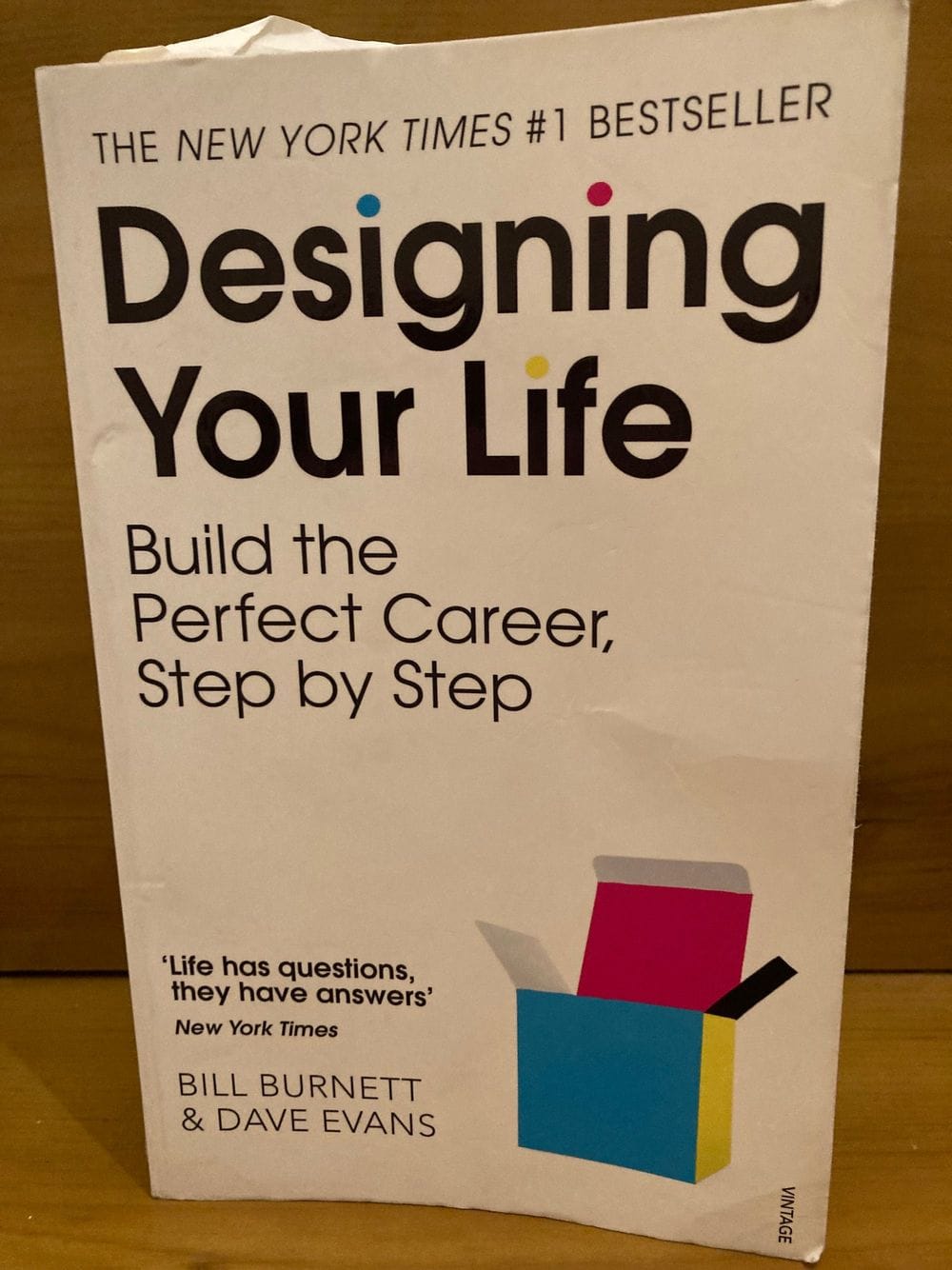Designing Your Life (Bill Burnett & Dave Evans) - Book Summary, Notes & Highlights
Life is a process and not an outcome. We should strive to design lives that align with our lifeviews and workviews to create fulfilling lives.

Stanford professors Bill Burnett and Dave Evans show us the power of leveraging design principles to build the life you want in their book Designing Your Life: Build the Perfect Career, Step by Step. The book presents frameworks and methods to become better at solving life's biggest problems.
I wrote a bit about my thoughts on this book and my workview and lifeview in this blog post from a few years back: Navigating Life. It has taken me a long time to digest and finish this book, but I am glad I did. I found it an incredibly valuable read.
⏳The Book in 3 Sentences
- We are all going to live multiple lives within our lifetimes and we should plan accordingly.
- Designers imagine things that don't exist yet and bring them into the world, similarly in life design we imagine possibilities and then work to make them real.
- Our lives are processes and not outcomes. life is continually evolving and designing our lives is a big part of what life is.
🎨Impressions
This book writes about the topic of life design and career planning from the perspective of two designers from the famous Stanford d.school. The book presents the reader with actionable steps and frameworks to tackle some of life's hardest questions.
The book is not only full of information but also many useful exercises that help the reader understand the points the authors are making. Reading the book and doing the exercises felt more like taking a course than reading a book. Of course, this also means it takes longer to finish the book, but I found the exercises well worth doing and provided me with many insights.
📖Who Should Read It?
I would highly recommend this book to anyone who is wrestling with hard questions about life, career, or personal challenges. The book is written in a course-like way where the authors are teaching you about design principles and applying them to life problems along the way. I believe you will find it helpful if:
- You are wrestling with questions about career choices and unsure which path to take.
- You have an interest in design thinking and would like to learn more about the application of design frameworks.
- You are considering making a pivot or change in your life. The book will be helpful in giving you tools to explore your options
👩🏫Lessons I Have Learned
How my life / behavior / thoughts / ideas have changed as a result of reading the book.
- It helped me reframe how I view my career and life. Living life is all about making choices and changes to your life to solve the problems you are facing.
- The Odyssey Plans in the book helped me to identify some things that I did not know I wanted from life and highlighted other areas that I did not feel were so important.
- I did some of the exercises with friends and family and found that it led to deep and interesting conversations.
📝Summary + Notes
The book is a great insight into how design frameworks and principles can be useful tools for solving problems. Bill Burnett and Dave Evans exemplify the power of life design through many anecdotes from both their own lives and their students. The book not only contains stories and information but also exercises giving actionable advice. I would view the book almost like taking a course in a book form.
The authors conclude that a goal in our lives is coherency. What do they mean by this? Well, they believe you should easily be able to connect these three points:
- Who you are
- What you believe
- What you are doing
To establish this coherency they present the concepts of a workview and a lifeview which can be used as a compass when making decisions in life.
1. Create a life compass to navigate your way through life
As stated a workview and a lifeview can be useful in creating a life compass. I wrote in more detail about these concepts here. A short summary is that a workview is your fundamental view of work. It describes the way you view the role of work in your life and what you believe makes it meaningful. A lifeview is instead your view on life. It describes what you value in life and what is important for you to live a good life. Combining your views on life and work gives you a good starting point for what direction you want your life to go. It can be highly beneficial to write these down and then come back to them from time to time to ensure that your life is aligned with your values and goals. This will not give you the absolute answers but can be a helpful tool in figuring out solutions to life challenges.
"Designing your life is actually what life is, because life is a process, not an outcome."
"Here's another key element when you're wayfinding in life: follow the joy; follow what engages and excites you, what brings you alive."
2. You will live many lives in your lifetime
In terms of careers most of us will be working for 40+ years which gives us the opportunity to try many different career paths, but many of us will also be parents, athletes, musicians, and whatever else we want to do in our lives. It is important to remember this multiplicity of life. We should not get stuck in thinking that we will only live a single life path as that can be limiting. A good exercise to figure out what we might want to do with our multiple lives is the Odyssey Plan.
The Odyssey Plan is an exercise from the book where you brainstorm three different paths your life might take. It is a great exercise to let your creativity flow when it comes to life design. I found it helpful to gain better insight into things I wanted from my life. The exercise is built around imaging what three different lives might look like for the next 5 years:
- Life one: That thing you do = Life one is the path you are currently on. Where does the path lead for the next 5 years? This should be what you currently have in mind.
- Life two: That thing you’d do if thing one were suddenly gone = Your plan B, if you had to pick an alternative path to the one you are on currently what would you do? You still need to pay rent.
- Life three: The thing you’d do or the life you’d live if money or image were no object = A “dream” life, if you had no obligations or societal responsibilities what is the thing you would pursue then? This could be something far-fetched and should help to expand your creativity regarding life.
Doing the exercise you can draw it up using a paper. Don't forget to add other things than your career to the plan. If you want to run a marathon add that, or if you want to learn Spanish this is also good to add. I encourage you to draw some of the things in your plan to help illustrate and show what it is you want to do. A good next step might be to compare your Odyssey Plan with some friends or discuss yours to dive into why it looks like it does. This is a helpful exercise to understand yourself better.
“The truth is that all of us have more than one life in us. When we ask our students, ‘How many lifetimes' worth of living are there in you?,’ the average answer is 3.4. And if you accept this idea-that there are multiple great designs for your life, though you'll still only get to live one-it is rather liberating“
3. The best way to figure out what you want in life is to prototype potential lives and see what you like and dislike
Figuring out what we want to do with our lives is an incredibly challenging problem. A helpful tool to solve this challenge can be to prototype different lives. An easy way to begin prototyping live is to start having Life Design Interviews with people who seem to be living lives you find fascinating. In such an interview you ask questions and let the person tell you their life story enabling you to have an insight into their life and if it still seems like an interesting path in life.
"the only way to know what they want to do is to prototype some potential lives, try them out, and see what really resonates with them"
“Prototyping the life design way is all about asking good questions, outing our hidden biases and assumptions, iterating rapidly, and creating momentum for a path we'd like to try out. Prototypes should be designed to ask a question and get some data about something that you're interested in”
4. Find a group of people you can turn to for counsel when you need it
These are the people you can call or talk to when facing life or career decisions. It is important here that they counsel you and don't give you advice. The distinction the authors make is that counsel will help you to figure out what it is that you want, meanwhile, advice is someone trying to push their realities onto you. Scott Galloway calls this creating a kitchen cabinet of people you can talk to. They are people who know you and care for you, helping you figure out what is in your best interest. These should be people that you trust to be honest but also helpful.
“Counsel is entirely different. Counsel is always helpful. You can never be too clear on your own thinking”
"Counsel and Advice. We make a clear distinction between counsel and advice. 'Counsel' is when someone is trying to help you figure out what you think. 'Advice' is when someone is telling you what he or she thinks.”
5. Become failure-immune by failing fast and often. Then make sure you are learning from your failures
It is important to fail at times because if we never fail we are not ambitious enough in our goal-setting. To fulfill our potential we must push the limit and as a result, we will sometimes fail. A key part of becoming successful is handling rejections and failure. Failure immunity is a little bit like a muscle we can train, if we have many small failures along our journey we will become more resilient. Developing grit and resilience will set you up for success down the line as you are willing to sometimes take a risk. Being open to calculated risk-taking can be helpful both to living a successful and fulfilling life as was mentioned in the summary of The Start-up of You as well
"This is the first level of failure immunity-using a bias to action, failing fast, and being so clear on the learning value of a failure that the sting disappears (and, of course, you learn from the failure quickly and incorporate improvements)"
